_
|
123 FIGHTER SQUADRON |
|
|
 |
|
|
|
HISTORY |
|
|
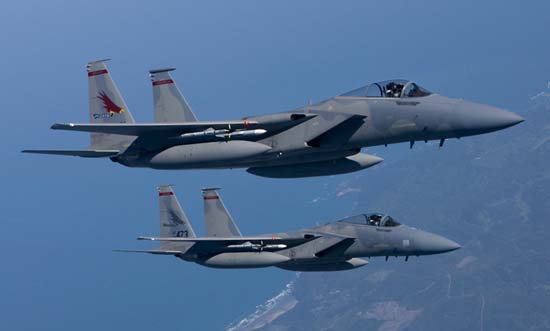 |
|
|
|
Allocated to the Oregon
National Guard in 1940, activated on April 18, 1941 at Portland
Municipal Airport. The newly formed unit began operations with two
officers, 108 enlisted men, and two aircraft, a North American BC-1A
(like the AT-6) and a Douglas O-46A. The squadron flew observation
missions primarily along the Pacific Coast and occasionally made mail
flights.
|
|
|
|
Ordered to active
service in September 1941 as part of the pre-World War II buildup of the
United States Army Air Corps and assigned to the 70th Observation Group,
Fourth Air Force. After the Japanese attack on Pearl Harbor, flew
anti-submarine patrols along the Pacific Coast from airfields in Oregon
and Washington, later becoming part of the air defense forces of
Southern California. This included one of the first missions flown from
a U.S. base on December 7, 1941. Flew anti-submarine patrols until
mid-1943 when the mission was turned over to the United States Navy.
|
|
|
|
Reassigned to Third Air
Force, the squadron was first sent first to Texas, then to Oklahoma for
combat reconnaissance and aerial photography training to support Army
ground forces. After training, the unit deployed to China Burma India
Theater, as part of the Fourteenth Air Force where they engaged in
unarmed observation flights over Japanese-held territory supporting
Chinese Nationalist forces. Flying B-25 Mitchells, A-20 Havocs, and DB-7
Boston Havocs originally built for the RAF the squadron flew from rough
and remote airfields in China throughout the rest of the War, later
converting to the unarmed high-speed long-range P-38 Lightning's and F-5
Reconnaissance Lightning's. The squadron received credit for
participation in seven campaigns in World War II.
|
|
|
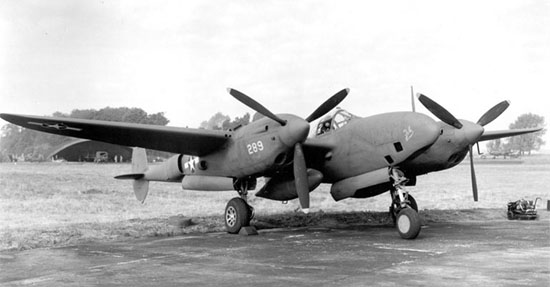 |
|
Lockheed F-5A
Lightning is the photo - reconnaissance
variant of the famous P-38. The "F" designation was use for aircraft
with a photo mission.
|
|
|
|
|
|
Not all 123d personnel
served with the 35th Photographic Reconnaissance Squadron (35th PRS), as
some were diverted to other units as early as 1942 and served elsewhere
in the Pacific and in Europe. As part of the large drawdown of forces
after the war, the 35th PRS inactivated on November 7, 1945 at Camp
Kilmer, New Jersey.
|
|
|
|
The wartime squadron,
designated the 35th Photographic Reconnaissance Squadron redesignated as
the 123d Fighter Squadron, Single Engine and was allotted to the Oregon
Air National Guard, on May 24, 1946. It was organized at Portland
Municipal Airport, Oregon and was extended federal recognition on June
26, 1946 by the National Guard Bureau. The 123d Fighter Squadron was
bestowed the history, honors, and colors of the 35th PRS. The 123d FS
was assigned to the 142d Fighter Group at Portland Municipal Airport
beginning fighter operations for the first time in the North American
F-51D Mustang with 75 officers and 800 enlisted men. The units were
allotted to Continental Air Command, with a mission of the air defense
of the State of Oregon.
|
|
|
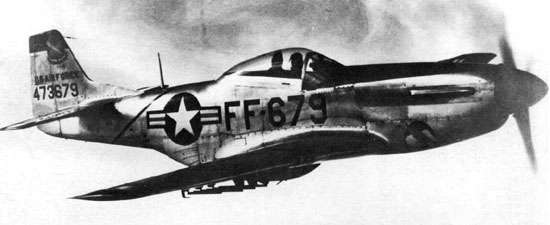 |
|
North American F-51D
Mustang of the 123rd FIS during the units Korean War activation.
|
|
|
|
As a result of the
Korean War, the squadron was called to active duty on 10 February 1951
and redesignated as the 123d Fighter-Interceptor Squadron falling under
the command of the McChord AFB based 325th Fighter-Interceptor Wing and
later, the 4704th Defense Wing in February 1952 after the inactivation
of the 325th FIW. The squadron conducted air intercept training missions
with its F-51s until June 1952 when it was re-equipped with the F-86F
Sabre daylight interceptor. On 1 November 1952, the 123rd was released
back to the Oregon ANG after its personnel, mission, and equipment were
absorbed by the newly activated 357th Fighter-Interceptor Squadron.
|
|
|
|
Re-formed as part of
the 142d Fighter-Interceptor Group with F-86A Sabres the 123rd resumed
its peacetime mission of the air defense of Oregon. In 1955, the
Redhawks transitioned to the F-94A Starfire and a new mission. With this
new all-weather interceptor, the mission of the 123d Fighter-Interceptor
Squadron changed from day interceptor to day and night all-weather
interceptor. In 1957, the 123d again upgraded to the improved F-89J
Scorpion then in 1966 to the supersonic F-102A Delta Dagger. In the
summer of 1958, the 142d implemented the ADC Runway Alert Program, in
which interceptors of the 123d Fighter-Interceptor Squadron were
committed to a five-minute runway alert 24 hours a day, 7 days a week,
365 days a year.
|
|
|
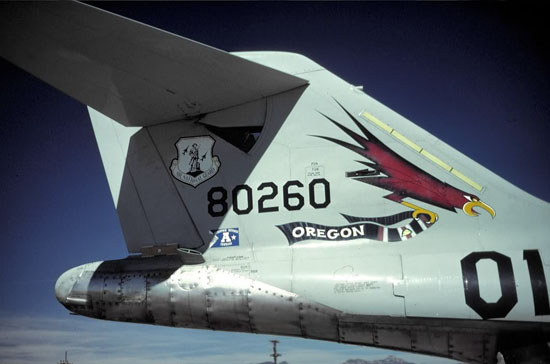 |
|
In the mid 70's
F-101 VooDoos were the first aircraft to wear the 123 FIS "Redhawk"
tailflash.
|
|
|
|
In 1972, the Redhawks
transitioned into the Mach-2 F-101B Voodoo. As an example of the unit's
readiness and capability, in 1976, the unit won top honors at a pair of
Aerospace Defense Command (ADC) competitions, the Weapons Loading
Competition and the famous William Tell Air Defense Competition. In
William Tell 1976, the 123rd FIS / 142nd FIG garnered first place in the
F-101 category and Lt. Col. Don Tonole and Maj. Brad Newell captured the
overall "Top Gun" title flying the McDonnell F-101B Voodoo.
|
|
|
|
After the inactivation
of Aerospace Defense Command in 1979 and the units re-assignment to
Tactical Air Commands Air Defense, Tactical Air Command (ADTAC), the
123d began replacing its VooDoo's with the F-4C Phantom II in 1981.
Success came again at William Tell 1984 when the unit placed first in
the F-4 category flying the McDonnell-Douglas F-4C Phantom II and beat
many of its F-15 Eagle and F-106 Delta Dart rivals in the overall
competition. Majors Ron Moore and Bill Dejager were the overall F-4 "Top
Guns" of the competition. Two years later, the 142nd FIG / 123rd FIS
sent the oldest airplanes flown by the youngest aircrews the 1988
edition of the William Tell Weapons Meet. The team, whose ranking member
was a Captain, placed first in the F-4 category again beating many
newer, more advanced fighters.
|
|
|
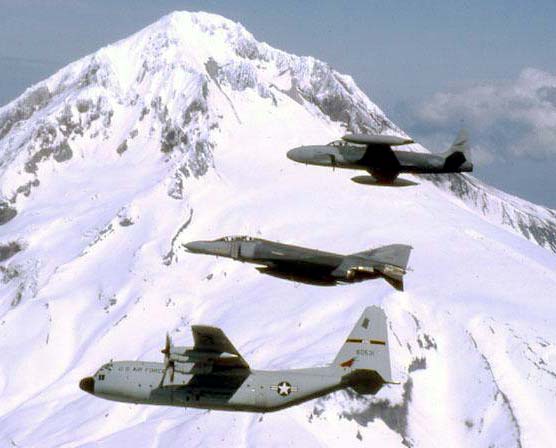 |
|
Classic photo of
aircraft assigned to the 123rd FIS / 142nd FIG in the 80's, T-33A
T-Bird, F-4C Phantom & C-130A Hercules, all would be retired by the
1990.
|
|
|
|
On October 6, 1988, the
last Redhawk T-33 left the base for retirement it was the only remaining
T-33A in the Air Force inventory at that time. The Oregon Air National
Guard received its first T-33A in June 1954; later five more arrived and
each of these six aircraft flew more than 2,000 hours. The first T-Bird
to arrive was aircraft number 53-5943, which was straight from the
factory with fewer than 20 hours of flight - the Oregon Air Guard put
9,556 total hours on it during its assignment with the 123rd. Oregon Air
Guard flew it for a total of 34 accident-free years. Oregon never lost a
T-33A to an accident, and never had an engine failure in flight. The
T-33s assigned to the Oregon Air Guard averaged 12.6 hours of manual
labor per flying hour. The sorties averaged 1.5 hours in duration.
|
|
|
|
In 1989, as part of
upgrade to the Air National Guard's interceptor inventory, the 123rd FIS
/ 142nd FIG began to receive F-15 Eagles from the 318th Fighter -
Interceptor Squadron, an active duty unit from McChord AFB slated for
deactivation as a part of a Cold War drawdown. The Redhawks F-4s were
the last of the "C" model flown by a USAF were flown to various basis
combat coded fighter squadron. After receiving it last F-15 its last
F-15, the Redhawks re-established their alert commitment at Portland on
December 29, 1989. On February 1, 1990 Det. 1 142 Fighter Interceptor
Group was established at McChord AFB manned by pilots and aircraft of
the 123rd FIS. On Sept 30, 1993, the detachment was deactivated as a
part of the Department of Defense force reduction plan.
|
|
|
 |
|
Three versions of
the F-15 camouflage schemes are displayed in this photo -t he "Ghost
Gray" scheme is worn by F-15A S/N 76-0073, a "PACAF" Scheme worn by S/N
76-0099 (with a low-vis tailflash), and the final "Mod Eagle" scheme
worn by 76-0142.
|
|
|
|
In 1992, as part of a
large USAF reorganization, the squadron was redesignated as the 123rd
Fighter Squadron.
|
|
|
|
Over the next few
years, the Redhawks would progressively upgrade their fleet of F-15s
with new aircraft; receiving Multi Stage Improvement Program (MSIP)
F-15A/B models between 1992 and 1995 replacing the early F-15's most
coming from the 318th FIS. On May 5, 2007, the Redhawks entered the next
chapter in their 19 year F-15 history with the arrival of their first
two F-15C's from Kadena Air Base in Japan. On Sept 17, 2007, the 123rd
retired the USAF's final combat coded F-15 closing the book on the
F-15A/B in USAF service.
|
|
|
|
Since the end of the
Cold War, the 142d has served as the principal air defense unit of the
Pacific Northwest. With more than 1,000 officers and airmen, the 123rd
Fighter Squadron guards the Pacific Northwest skies from northern
California to the Canadian border, on 24-hour Air Sovereignty Alert as
part of Air Combat Command and the North American Aerospace Defense
Command (NORAD). The wing also stands ready to participate in state and
federal contingency missions as required.
|
|
|
|
The Redhawks have
participated in a wide variety of expeditionary missions in the
turbulent post-Cold War environment while providing air defense of the
Pacific Northwest. These included major deployments to Turkey in 1998
for Operation Northern Watch and to Saudi Arabia in 2000 for Operation
Southern Watch, patrolling the no-fly zones then in place over Iraq. The
squadron deployed aircraft to Panama in 1998 in support of counter-drug
missions, helping stem the flow of the drug trade by air. In response to
the 9/11 Attack on America the Redhawks maintain an alert presence under
Operation Noble Eagle, the national military response to homeland
defense.
|
|
|
 |
|
The Redhawks now
fly the most advance F-15 eagles in the Air Force.
|
|
|
|
|
|
LINAGE & HONORS |
|
|
|
Lineage - Designated 123d
Observation Squadron, and allotted to Oregon National Guard, on 30 July
1940. Activated on 18 April 1941. Ordered to active service on 15
September 1941. Redesignated: 123d Observation Squadron (Light) on 13
January 1942. Redesignated: 123d Observation Squadron on 4 July 1942.
Redesignated: 123d Reconnaissance Squadron (Bombardment) on 2 April
1943. Redesignated: 35th Photographic Reconnaissance Squadron on 11
August 1943. Inactivated on 7 November 1945. Redesignated 123d Fighter
Squadron and allotted to Oregon ANG 24 May 1946. Extended federal
recognition on 26 June 1946. Federalized and placed on active duty, 10
February 1951. Released from active duty and returned to Oregon state
control, 1 November 1952. Re-designated: 123d Fighter-Interceptor
Squadron, 1 November 1952. Re-designated: 123d Fighter Squadron 31 March
1992.
|
|
|
|
Assignments - Oregon
National Guard, 18 April 1941. 70th Observation (later Reconnaissance)
Group, 15 September 1941. 77th Tactical Reconnaissance Group, 11 August
1943. Attached to 70th Tactical Reconnaissance Group to 31 October 1943.
III Reconnaissance (later Tactical Air) Command, 30 November 1943. AAF,
India-Burma Sector, 5 May 1944. Fourteenth Air Force, c. September 1944.
Tenth Air Force, 1 August 1945. Fourteenth Air Force, 25 August 7
November 1945. Oregon Air National Guard, 24 May 1946. Gained by Fourth
Air Force, Air Defense Command. 142d Fighter Group, 30 August 1946.
325th Fighter-Interceptor Wing, 10 February 1951. 4704th Air Defense
Wing, 6 February 1952. 142d Fighter-Interceptor Group 1 November 1952.
142d Fighter Group 16 March 1992. 142d Operations Group, 1 October 1995
Present
|
|
|
|
Stations - Gray Army Airfield, Washington, 25 September
1941. Detachment operated from Bowerman Field,
Washington, 15 March-c. August 1942. Ontario Army Airfield, California,
16 March 1943. Roberts Field, California, 20 August 1943. Gainesville
Army Airfield, Texas, 10 November 1943. Will Rogers Field, Oklahoma, 5
February 10 April 1944. Guskhara Airfield, India, 13
June 1944. Kunming Airport, China, 1 September 1944. Flight at Nanning
Airfield, China, 16 September 6 October 1944. Flight at
Yunnani Airfield, China, 16 September 1944 10 February 1945.
Chanyi Airfield, China, 17 September 1944. Flight at
Chihkiang Airfield, China, 19 October 1944-c. 1
September 1945. Flight at Suichwan Airfield, China, 19
NOV 1944 22 January 1945. Flight at Chengkung
Airfield, China, 10 February 13 May 1945. Flight at
Laohwangping Airfield, China, 27 February-c. 1 September 1945. Flight at
Kunming Airport, China, 14 May 31 July 1945. Flight at Nanning
Airfield, China, 31 July-c. 1 September 1945. Luliang
Airfield, China, 1824 September 1945. Camp Kilmer, New Jersey, 57
November 1945. Portland International Airport, Oregon, 23 June 1946 1
November 1952. Designated: Portland Air National Guard Base, Oregon,
1991-present
|
|
|
|
Aircraft - O-47, 1941-1945; O-49 Vigilant, 1941-1945;
O-46, 1941-1942; B-25 Mitchell, 1943-1944; A-20 Havoc, 1943; DB-7
Boston, 1943; P-39 Aircobra, 1943-1944; P-38
Lightning, 1944; F-5 Lightning, 1944-1945; B-25 Mitchell, 1945; F-51D
Mustang, 1946-1952; F-86F Sabre, 1952-1955; F-94A Starfire, 1955-1957;
F-89J Scorpion, 1957-1966; F-102A Delta Dagger, 1966-1971; F-101B
Voodoo, 1972-1981; F-4C Phantom II, 1981-1989; F-15A/B Eagle, 1989-2009;
F-15C/D Eagle, 2007Present
|
|
|
|
|
|
|
|
ASSIGNED AIRCRAFT |
|
Please email
greendragonsden@yahoo.com
with any additions to the lists below. |
|
|
|
F-15A |
|
|
|
76-0034
|
76-0050
|
76-0051
|
|
76-0059
|
76-0066
|
76-0070
|
|
76-0071
|
76-0073
|
76-0075
|
|
76-0077 |
76-0091
|
76-0092 |
|
76-0093 |
76-0095
|
76-0098
|
|
76-0099
|
76-0102
|
76-0105
|
|
76-0106
|
76-0108
|
76-0109 |
|
|
76-0111 |
|
|
|
|
|
|
F-15B |
|
|
|
76-0139
|
76-0141
|
76-0142
|
|
GREEN = FORMER 318
FIS F-15s - - - RED = COMMAND ACFT |
|
F-15A MSIP |
|
|
|
73-0089
|
75-0040
|
75-0057
|
|
75-0061
|
75-0068
|
76-0041
|
|
76-0043
|
76-0045
|
77-0063 |
|
77-0073
|
77-0086
|
77-0091
|
|
77-0098
|
77-0108
|
77-0119
|
|
77-0123
|
77-0126
|
77-0132 |
|
|
|
|
|
F-15B MSIP |
|
|
|
76-0141 |
76-0142
|
|
RED = COMMAND ACFT |
|
F-15C |
|
|
|
78-0473 |
78-0479
|
78-0482 |
|
78-0492
|
79-0050
|
79-0069
|
|
80-0026
|
80-0028
|
82-0016
|
|
84-0002
|
84-0005 |
84-0007
|
|
84-0020
|
84-0026
|
84-0030
|
|
84-0031
|
85-0094
|
85-0100
|
|
|
85-0106
|
|
|
|
|
|
|
F-15D |
|
|
|
85-0130
|
85-0132
|
86-0151 |
|
RED = COMMAND ACFT -
- - GREEN = MIG KILLER |
|
|
 |
|